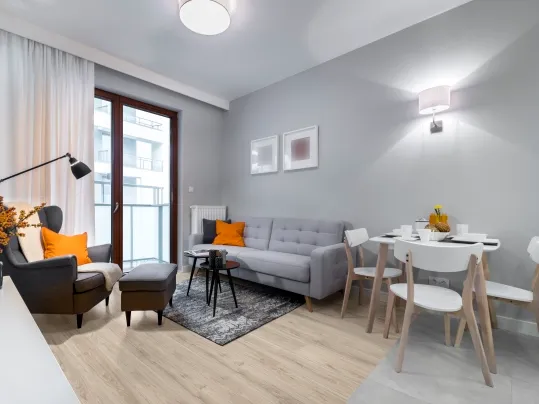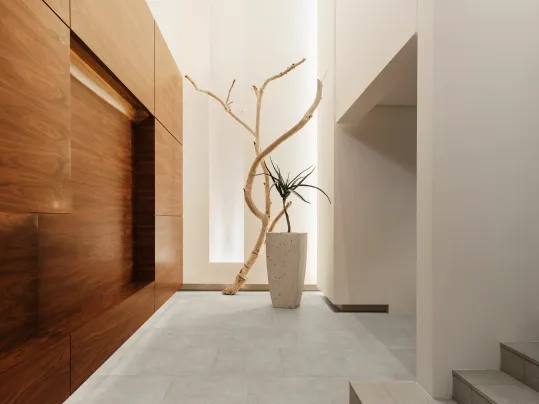A Vision for Compact Living
FX Magazine Roundtable
April 2020

After teaming up with FX at the end of last year at our London Showroom in Clerkenwell, the magazine brought together experts from across architecture and design to consider the challenges and opportunities of compact living, and whether the concepts of ‘luxury’ and ‘space’ are forever intertwined.
Theresa Dowling: Editorial Director, FX Magazine (Chair of the discussion)
Tim Bowder-Ridger: Senior Partner, Conran + Partners
Emily Cassel: Associate, LOM Architecture
Harry Harris: Director, SUSD
Andrei Martin: Partner, PLP Architecture
Justin Nicholls: Principal, Fathom Architecture
Rob Owen: Head of Interior Design, The Manser Practice
Simon Saint: Principal, Woods Bagot
Bronte Turner: Principal and Managing Director of London HLW
Julie Haake: Forbo Key Account Manager, PRS
Jason Pethard: Forbo Head of Key Accounts

A growing population, twinned with steadily increasing demand for city living, has seen house prices in certain areas skyrocket, squeezing many out of the market for both purchasing and renting homes. According to the National Housing Federation, an estimated 8.4 million people in England alone are living in unaffordable, insecure or unsuitable housing. It is a far-reaching topic that strikes right at the heart of politics and wider society, and yet it is likely to be developers and architects working in tandem who will come up with the ideas and practical solutions that will ultimately address the problems.
So, does a compromise on space inevitably mean a reduction in quality? And is luxury a question of space?
Brendan: We do projects at both ends of the space spectrum and I think for many people luxury today is to do with size and whether you can afford a bigger space, but on the other hand, in hotels for example, it is as much to do with facilities. There may be a decrease in conventional “living space” but an expansion of ancillary space in order to deliver the other services that are increasingly required.
Justin: It is also important to define what we mean by “compact”. For example, in the city, are we talking about density and the number of homes located within a small area, or is it purely in terms of the space within an individual home? There are some really high-density developments around where homes are close together and with quite small dimensions, but then they have been built alongside open spaces such as parks and rivers, which help to give the sense of a greater space.
Harry: We’ve been working with The Collective, a scheme in Canary Wharf that features 705 studio apartments in a 20-storey tower. Individually, they are very small – typically 18-20m2 – but they come with the shared features of a swimming pool on the roof, climbing wall, gym, cinema, disco, laundry and shared kitchen. So, the amenity space is probably better than you would find in a house in Soho, albeit with a very small space for private living. Many of the people who will live there are generally time-poor and, to a certain extent, cash-rich. They might be well-paid graduates who don’t want to live in a grubby house-share in poor-quality accommodation, and so this kind of development offers a real alternative.
Tim: I think the definition of luxury has changed quite a lot too. We all probably tend to measure it from the point of view of our parents’ generation. We’re typically all living in houses smaller than our parents’, but for those living in small homes that have facilities like hotels, that’s fine if that is your choice.
Simon: Choice is key, and people are starting to choose different compromises. If you want to live in Shoreditch but can only afford a certain size or type of home, then the decision is whether living in that area is more important than a second bedroom or a larger living room. There is a lifestyle choice being made there. The important thing is to understand the choices being made and delivering the right kind of housing to enable those choices to be made, as opposed to just seeing the size of houses get steadily smaller as a matter of course, to the point where if you’re wanting to live anywhere in or near London then it will have to be somewhere tiny.
Bronte: When I first came to the UK from Australia, I noticed a huge difference in multi-res schemes that I had grown up with and experienced back home, compared to what existed here. In Australia it was about luxurious, high-rise living, whereas coming here, multi-res still had a social housing stigma attached to it. Over the past 15 years though, things have shifted in the UK. There is still an element of social housing, but it is now a lot more about luxury and transport connections.
The difference back then was really stark. I remember one of my first meetings with the marketing team for a developer of one scheme and was shocked how, instead of the emphasis on luxury and cutting-edge design that such projects focused on in other countries, they were talking about not fitting skirting boards in order to maintain the largest possible square feet measurement in the apartments. The discussion wasn’t about quality at all, purely the space.
There are some terrible developments in London though, based solely on the measurements and with little attention paid to clever design. What’s exciting now though is that people are increasingly realising that you can have compact living with really good, thoughtful design and that this can create something of far higher value.


Creating developments in which the emphasis is on smaller apartments but with greater space given to shared facilities is only part of the equation, though. Andrei warned that designing these into a scheme is not necessarily enough to make them a success – it needs to be backed up through effective marketing and ensuring that the facilities are being fully utilised in the way in which they were intended.

Harry: There is an additional benefit of this kind of living in that, where done well, it can help to create a real sense of community that may not exist elsewhere in properties where residents keep themselves to themselves. Particularly for someone coming to live here from abroad, London can be an incredibly difficult place to integrate and meet people, or to find a community straight away. That can bring with it a certain appeal, although with the danger that it most appeals to those that do not necessarily have this in their lives up to now and who may, despite all the social events going on, still hide behind their laptop rather than fully embrace it.
Emily: It also depends on the facilities that are on offer too. A creche, for example, brings a development within the focus of a whole different potential tenant.
Justin points to the example of The Collective at Canary Wharf as a way of coming at things from a slightly different angle: ‘They’ve approached it almost as a piece of hospitality. It is as close to a hotel as it is to a residential development, and they’ve worked really hard to develop that.
Tim: ‘We talk about improvements in design for residential, but what we’ve seen over the last 10 years is massive investment from developers in what they see as high-end. They’re having to compete with other developments, which leads to them throwing more and more different initiatives into their projects. At the lower end of the market, thankfully we do have standards that ensure that we’re making decent homes. It’s in the middle market where things get difficult, where they start applying these “space-saving” devices purely to enable them to maximise volume.
Bronte: Too much of one type of product locks people in a little too much. When we’re in our 20s, a more communal living approach is more likely to appeal, but as we get older, partner off and have children, this type of housing is just not a viable option for family life from a humanistic point of view.

Andrei believes that delivering the right kind of housing to meet evolving demands will become an ever-increasing challenge, especially since work patterns moving towards a more flexible, home-based or out-of-town system appears to have been a passing phase: The population is growing and young people will continue to move to global cities that attract talent – and London happens to be one of them. There was a great moment of promise a few years ago where remote working looked to be the way forward, with the realisation that you don’t have to be in the centre of town. That was seen for a brief time as a way to alleviate the housing crisis as it would allow a better distribution of the workforce.
It proved to be entirely wrong because in the work environment we still want to be together and see each other. But one thing that does offer a degree of hope is the question over what counts as an urban centre. So, in London’s case, it is mainly all concentrated in zones 1 and 2, but outside of that, there is scope for the sort of togetherness to be created through density to give the sense that you are in a hub of energy.
On the subject of ensuring that a development ends up being home to a social mix of people, Bronte: I read recently of a trial where a kindergarten was located in the same building as a nursing home, examining the benefits of co-existence within a community
Brendan: In a sense, when we look at the co-living developments, it’s almost like a care home in principle. There is a case for these buildings having a real mix of families, with young children as well as older residents all in close proximity.
Rob: We’re involved with a development in Wembley that will comprise thousands of PRS homes, and one particular project we’re working on at the moment is aimed at adults with children. We are doing all the amenity areas, which, once completed, will be full of lots of children, and it’ll work well for everyone because everyone else also has children. But because it is such a large estate there, they are able to aim different blocks at different people, which means that the amenities can be tailored to suit. It is next level in terms of scale, not just 200 or 300 units in one building, but 5,000 or 6,000 homes.
Harry considered planning and space standards to be absolutely key: In terms of space, social housing standards are much higher than private developers, more generous, and with storage and circulation factored in, as well as extended care for when people get older. But what the free market is doing to an extent is ghettoising young people in one block, families in another, whereas years ago it used to be more mixed.
Simon: It’s worth bearing in mind that the really tiny homes only really work on a rental basis. I don’t think they work on a for-sale basis, so you have to have an operator who is invested in maintaining the property throughout the duration of its entire life. That often leads them towards a higher-quality approach because it works better for them in the long run. In terms of mixing the types of properties up within a development, the problem with putting in a number of three-bed properties is that there is almost no-one who is able to afford them, especially in the “for-sale” market. When you start applying the square foot rate to a property like that, you then find yourself asking how many families have £3m for a three-bed apartment?
So that’s one of the reasons there is a tendency to create developments that meet specific needs rather than a building full of “half gestures” that tries to please everyone, but which works for some and not others. It’s a case of finding a way of mixing it in some way without diluting it to the point that it doesn’t really work for anyone. It’s a real challenge.’
Justin: Local authorities can sometimes be more enthusiastic about three-bedroom homes on the theory that it’s a better way to grow a community. The thinking is that families tend to stay longer. It gives an interesting twist to the statistics – if you look in London at zones 1,2 and 3 there are lots of terraced houses quite often broken down into flats. Perhaps we should be building more one- and two-bedroomed homes and converting this older housing stock – which often have gardens and are ideal for families – back into houses.’
Andrei: If we can somehow identify both poles of adult life, and somehow offer a compelling alternative to people who, in later life, find themselves in many cases “stuck’” in large houses, it might be one way to ease some of the pressure on demand for family homes.
Achieving ‘community balance’ is something the architects around the table seemed acutely aware of as an important issue.
Tim: My big fear is the segmented approach to much of the new housing. Lots of homes are being built but too much is of the same type and style. The danger is that this will perpetuate some of the problems, leading to higher land values and allowing only certain people the option of living in certain areas. That is not about deliberate choice-making, it is having no choice at all, which is exactly what happens in Hong Kong.’
Bronte: I think the larger-scale mixed-use developments are thinking more about lives and lifestyles to an extent. It’s the singular ones that perhaps pay a little less attention to “community” in favour of more of a “rack ‘em and stack ‘em” approach.
Brendan: To be fair, everything is just left to the developer to make these decisions and that’s always going to be based mainly on self-interest. Is there a role for government to take a bigger role in the process to ensure wider issues are factored in?
Tim: It’s very fundamental. You can trace right back to the 1980s “right to buy” scheme, which in many ways took the anchor out of the market. Access to council homes gave people choices and forced developers to deliver to the market in different ways. Without that anchor it has all floated off.

Are the rules requiring developers to add ‘affordable housing’ elements to their luxury schemes helping to address some of these issues?
Tim: The flaw is that in some ways this is a way of getting developers to provide the sort of social housing that local authorities should be delivering. Ultimately for the end user, the cost is higher than it could be.
Rob: My problem with “affordable” is that 80% of a lot of money is not affordable for many people. There might be 40% of a development that is classed as affordable, but who is it affordable to? It’s still beyond the reach of a huge number of people.
Another issue for any large-scale scheme is creating spaces of distinction in a market where varying personal taste often leads developers to ‘play it safe’.
Justin: With the high-turnover/short-stay approach of some of these smaller properties, there is sometimes a blandness to the design. Because the developer doesn’t know exactly who is going to be coming to live there, there is a tendency to go for the typical white walls and simple styling.
Simon agreed: ‘The whole market is homogenous to an extent. Most developers offer the brief that they just want everyone to “not hate it”.
Heath: It does often come down to how brave the client is prepared to be in differentiating themselves and creating their own market.
Justin: I think in the last 10 years multi-res has become more sectorised, with student, co-living, build-to-rent, build-to-sell, and retirement living. That’s all potentially really good for architects and designers because we can add creative value to all of that and make them better places to live. It’s a real opportunity.